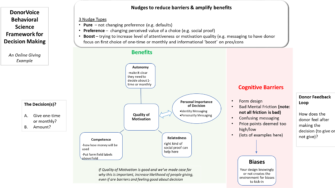Pure Nudges, Preference Nudges or Boosts?
Behavioral Science is too often being reduced down to a poor understanding of behavioral economics and an even poorer understanding of nudges, treating them as parlor tricks, akin to visual illusions.
Nudges aren’t predictions about what people will do, they are observations. For example, in certain situations people will tend to go with whatever is set as the default – e.g. one-time giving or monthly or becoming an organ donor because that’s the default setting – i.e. have to opt-out to not be organ donor.
These observations about “biases” influencing choices have deeper, psychological reasons behind them. Continuing our example, did I go with the monthly default option because,
- I was donating on a whim? Chances are good the quality of my motivation is crappy here and I’ll quit before you ever cover your cost to acquire.
- I don’t have a strong, existing preference for one-time or monthly? This might suggest I took a brief second to at least process what I was doing and had an ounce of intention behind it. But, you’ve likely left the door wide open to my deciding to quit and it comes down to timing – do I do so before or after you cover your cost to acquire?
- I put hardly any level of attentiveness or mental effort into the checkout. In this case, I’m going to call your donor service team and be irate because I didn’t intend to give monthly.
- I have a pre-existing preference for monthly giving, I’ve got a strong connection to your mission (based on my Identity), I am already somewhat committed to your brand and have a sense for how my money will be used and your default setting of “monthly” made it slightly quicker for me to checkout but also subconsciously reinforced my existing monthly preference as I assume other people must prefer monthly too, hence your default setting. I’m a donor for life.
These nuanced examples are hypothetical but no less real in that they happen every day on every donate form for every charity. People making choices and feeling either good, bad or in-between about the outcome.
And since the donor feeling good is a prerequisite to repeating the behavior it would seem we need a more nuanced, more expert view of decision making before we digitally circle the middle amount on the ask string and toss out a clumsy social proof message (e.g. other people like you gave this amount) because somebody on the digital team read a blog post written by someone who read a few pages of a ‘beach-read’, behavioral economics book.
To that end, here is a more extended view of how we think about decision making (click image to enlarge) and subsequent design of experiments with science-informed ideas on messaging, design and flow.

All this can be simplified to amplifying benefits and reducing barriers. But, the devil and angels (i.e. happier more profitable donors) are in the details. Our human biases matter and nudges matter but there is more than one type, a bucket-load in each type and they are only a part of the equation in human decision making.
Behavioral Science and your donors deserve better than to be reduced down to parlor tricks. We really aren’t a bundle of irrational, subconscious, low effortness. Instead, we’re messy, complex and mostly predictable, humans.
Kevin



Thank you soooo much for this post.
The amount of poorly thought out ‘parlor trick’ nudges and behavioural interventions out there is extremely frustrating.
So many interventions which are covid related often end up being counterproductive.
Thanks Terry for commenting. Yes, we’ve violated an Einstein maxim of making this as simple as possible but not simpler…